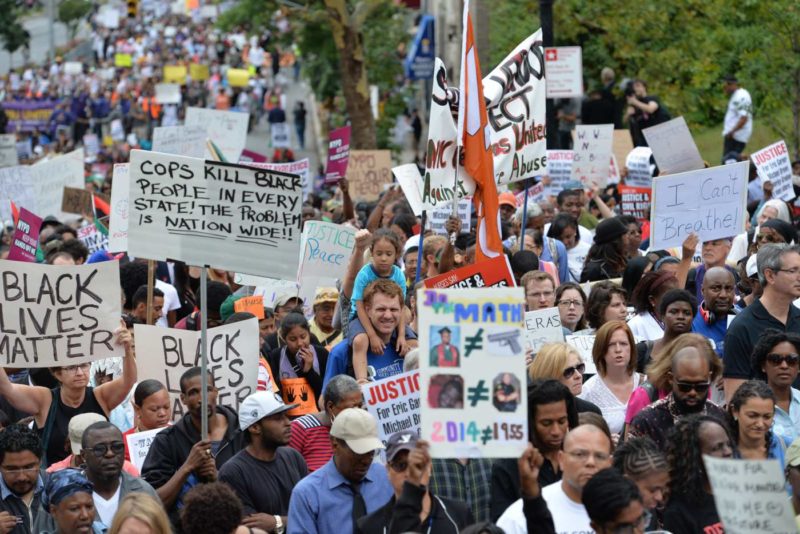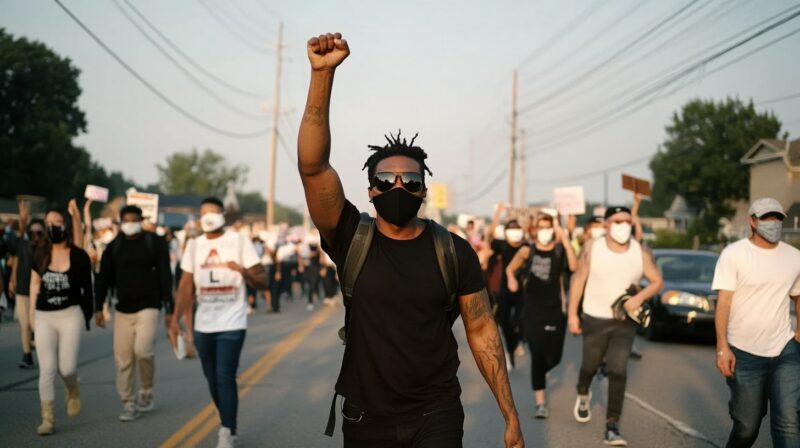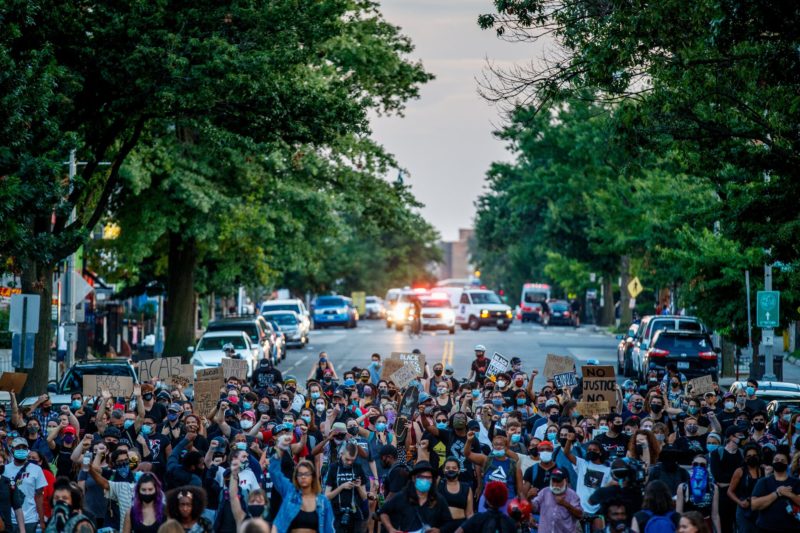Special News Series: Rising Up For Justice! – Black Lives Matter Grows as Movement While Facing New Challenges
Share
Explore Our Galleries
Breaking News!
Today's news and culture by Black and other reporters in the Black and mainstream media.
Ways to Support ABHM?
Introduction To This Series:
This post is one installment in an ongoing news series: a “living history” of the current national and international uprising for justice.
Today’s movement descends directly from the many earlier civil rights struggles against repeated injustices and race-based violence, including the killing of unarmed Black people. The posts in this series serve as a timeline of the uprising that began on May 26, 2020, the day after a Minneapolis police officer killed an unarmed Black man, George Floyd, by kneeling on his neck. The viral video of Floyd’s torturous suffocation brought unprecedented national awareness to the ongoing demand to truly make Black Lives Matter in this country.
The posts in this series focus on stories of the particular killings that have spurred the current uprising and on the protests taking place around the USA and across the globe. Sadly, thousands of people have lost their lives to systemic racial, gender, sexuality, judicial, and economic injustice. The few whose names are listed here represent the countless others lost before and since. Likewise, we can report but a few of the countless demonstrations for justice now taking place in our major cities, small towns, and suburbs.

To view the entire series of Rising Up for Justice! posts, insert “rising up” in the search bar above.
Black Lives Matter Grows as Movement While Facing New Challenges
Demonstrations against police shootings and a March on Washington on Friday reflect a cause more enduring than many predicted.
By John Eligon The New York Times
August 28, 2020

KENOSHA, Wis. — In some ways, what has unfolded on the streets of Kenosha, Wis., over the past week has had a wearying sense of familiarity.
There was another demoralizing shooting of a Black man by the police, another angry outcry in the streets, another disturbing trail of destruction that had the potential to overshadow the message of the need to end police violence and racism.
But as the demonstrations for Jacob Blake, the man shot in Kenosha, spread nationwide this week, and as civil rights leaders prepare to host tens of thousands of people in a March on Washington on Friday, this latest surge of protests reflects something much more — the remarkable way that the Black Lives Matter movement has come to represent a lever for change and a guiding voice on issues of race in America.
Black Lives Matter protests — or even the possibility of them — have changed the way that people in power respond. Elected leaders, including Gov. Tony Evers of Wisconsin, now tend to engage instantly and insistently with matters that in the past had been dealt with primarily by the police. Officers are named, details are shared and there are promises of thorough investigations — on Wednesday, by the Justice Department. In some instances, officers are charged or fired much more quickly than ever before.
And there is broader public witness and involvement. After a series of police killings several years ago, Colin Kaepernick imperiled his National Football League career by kneeling during the national anthem. Now, kneeling has become widely accepted in professional sports, athletes have refused to play games and players seriously debated shutting down the National Basketball Association playoffs entirely to make a statement.
“You’ve created an environment so whenever any incident of injustice or perceived injustice takes place, it’s going to be amplified,” said Daniel Gillion, a political science professor at the University of Pennsylvania, who studies protest movements.
And there is broader public witness and involvement. After a series of police killings several years ago, Colin Kaepernick imperiled his National Football League career by kneeling during the national anthem. Now, kneeling has become widely accepted in professional sports, athletes have refused to play games and players seriously debated shutting down the National Basketball Association playoffs entirely to make a statement.
“You’ve created an environment so whenever any incident of injustice or perceived injustice takes place, it’s going to be amplified,” said Daniel Gillion, a political science professor at the University of Pennsylvania, who studies protest movements.
Still, even as activists continue taking to the streets, many also believe that the changes are too slow and too modest. There is frustration over what protesters feel is the police’s continued unnecessary use of force against Black people.
But there is also increasing concern that images of vandalism, looting and arson are becoming inextricably linked with the protests, undermining efforts to win systemic reforms and public support. While the Black Lives Matter movement enjoyed broad approval in the weeks after George Floyd’s death in Minneapolis police custody, Democrats worry that the unrest, regardless of its extent or who is responsible, could help President Trump find a receptive audience for his argument that he will bring “law and order” to the country.

“We always must find ways to have peaceful demonstrations,” said Martin Luther King III, the son of the slain civil rights leader and an organizer of Friday’s march, which celebrates the 57th anniversary of the historic gathering his father led in Washington.
“While I don’t condone violence at all, I understand why people are resorting to violence,” he added. “You are victimizing a person as a society, and then you want to tell them, ‘You know, I got my foot on your neck, but you’re just supposed to let me put my foot on your neck.’ That’s not right.”
In the two weeks after Mr. Floyd was killed in May, more than 2,000 protests were held across all 50 states. The demonstrations were diverse, reaching both big cities and communities that were rural and overwhelmingly white. On June 6 alone there were at least 531 protests nationwide, according to Count Love, a database of protests since 2017.
The speed at which the protests of the last three months have spread and the scale of support they have received speak to the foundation that the Black Lives Matter movement has laid over the past several years, academics said.
The movement traces its origins to the killing of Trayvon Martin, a Black 17-year-old, by a neighborhood watch volunteer in Florida in 2012. But it really took off after a police officer fatally shot Michael Brown, 18, in Ferguson, Mo., in 2014.
For more than a year, protests flared up with new police killings. The Justice Department investigated police departments across the country and reached settlements with some to monitor their operations. Some police forces introduced new reforms, like making their officers wear body cameras.
Even after much of the media attention faded from the Black Lives Matter movement after Mr. Trump’s election in 2016, organizing and policy work continued. So when the devastating video surfaced of Mr. Floyd suffocating as an officer knelt on his neck for more than eight minutes, the infrastructure was there for activists to spring into action, experts said.
“Part of what’s going on this spring is continuity from six years ago,” said Pamela Oliver, a professor emeritus of sociology at the University of Wisconsin-Madison. “Groups had actually never stopped. All those street protests that were happening 2014 to 2016 died down after the fall election, but the issue didn’t die down.”
So far, this latest swell of Black Lives Matter activism is showing a durability that outpaces even the surge after Mr. Brown’s killing.
There have been more than 70 protests per week this month — which is two months removed from Mr. Floyd’s killing — according to the Count Love database, compiled using media reports. When Mr. Brown was killed in August 2014, there was a surge of more than 100 protests nationwide the week after, according to a different database, but that dropped to an average of about 15 per week for the rest of the month.
The recent persistence of Black Lives Matter demonstrations is partly the result of broader grievances in society, including the feeling among many on the left that Mr. Trump represents a threat to democracy, experts said. Youth activism in recent years on issues like climate change and gun rights has helped to cultivate a broader protest culture, experts said, and when reforms are won, it validates protesting as an effective action. Support from prominent celebrities and athletes also have helped to keep the momentum going.
“I definitely think it’s still at the same energy level,” Damayanti Wallace, 19, an organizer in Chicago, said of the protests in her hometown. “I think that youth especially are just very angry with the lack of progress that’s been happening in the city.”
Read the full article here.









Comments Are Welcome
Note: We moderate submissions in order to create a space for meaningful dialogue, a space where museum visitors – adults and youth –– can exchange informed, thoughtful, and relevant comments that add value to our exhibits.
Racial slurs, personal attacks, obscenity, profanity, and SHOUTING do not meet the above standard. Such comments are posted in the exhibit Hateful Speech. Commercial promotions, impersonations, and incoherent comments likewise fail to meet our goals, so will not be posted. Submissions longer than 120 words will be shortened.
See our full Comments Policy here.